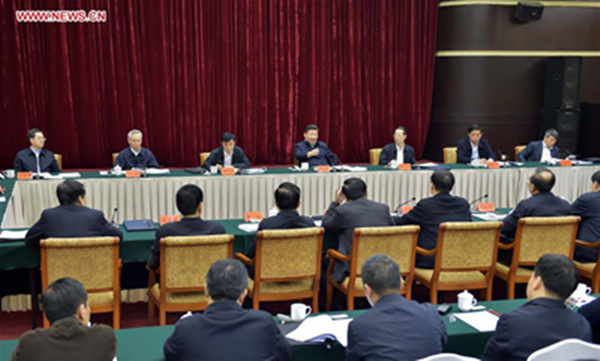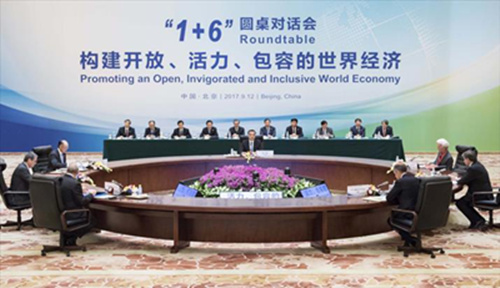By Tom McGregor, CCTV.com Panview commentator and editor
Editor's Note: CCTV.com Panview presents 'China Cares' — series of special coverage on China's rural reforms, charities and comprehensive efforts to help those in poverty unlock their potential for success.
Amid China's rapid economic development in the past few decades, over 700 million Chinese have escaped poverty to enjoy much improved living standards. Beijing had embarked on an urbanization drive that allowed hundreds of millions of migrant farmers to find better jobs in bigger cities.
The strategy seemed effective, but boosting the domestic manufacturing sector, had eventually led to increasing pollution.
But, Chinese President Xi Jinping is addressing the problem by calling for the Central Government to reform the nation’s economic structure in favor of Green development.

(Chinese President Xi Jinping stresses ecology and "green development" in boosting the growth of the Yangtze River Economic Belt in a symposium held in China's southwest Chongqing Municipality, Jan. 5, 2016. Photo from Xinhua by Li Tao)
Smart way for growth
China's Cabinet, the State Council, and the National People's Congress (NPC) have introduced measures to enact tougher laws against high-polluters, support shifting from coal and fossil fuels and provide more subsidies for renewable, green energy.
In a series of speeches, Xi proposed the five development concepts of "innovation, coordination, green, openness and sharing."
For the first time in China's history, "green development" was included in the NPC's 12th 5-year plan (2011-2015) and given added emphasis in the 13th 5-year plant (2016-2020).
Beijing's eco-friendly objectives have already delivered proven results. In 2012, clean energy - hydro, wind, solar and nuclear - accounted for 14.5 percent of China’s total energy consumption and it has risen to nearly 20 percent by the end of 2016.
Green energy giant
Hu Angang, dean of the Institute of Contemporary China Studies at Tsinghua University, highlighted that green policies not only support sustainable development, but can keep China’s economy resilient.
Chinese Premier Li Keqiang met with the directors of six international organizations at a meeting in Beijing on Sept. 12, 2017, known as the "1+6" Roundtable Forum.

(The Second "1+6" Roundtable meeting of Chinese Premier Li Keqiang (center) and heads of six international organizations is held in Beijing on September. 12 Photo from Xinhua)
China has become the world's leader in the green energy production and consumption markets. The renewable sector has witnessed explosive growth with over 300 million Chinese relying on green energy.
China is the world's largest customer of clean burning, liquefied natural gas (LNG), while working with Russia to construct pipelines that run from Siberia into China's power grid.
Northwest China's Qinghai Province has transformed into a hub for green energy and other regions will pursue stronger green development.
Yantgze River Economic Belt
The Yangtze River region has long been vibrant with economic activities and cultural background. The Yangtze is the country’s longest running river that opens up from the Tibetan-Qinghai Plateau and empties out at Shanghai's tributary.
The Yangtze River Economic Belt directly impacts the Chinese provinces and autonomous regions including: Shanghai, Jiangsu, Zhejiang, Anhui, Jiangxi, Hubei, Hunan, Chongqing, Sichuan, Guizhou and Yunnan.
President Xi pledged to fund the river’s course renovations with enhanced controls on water resources and treatment along with stricter measures to curb water pollution.
The Yangtze links China's Belt & Road Initiative, serving as the crucial connector to the Silk Road Economic Belt and 21st Century Maritime Silk Road.
Beijing will prioritize "green development" in the region "to respect natural, economic and social mores," according to Xinhua.
Restoring a 'Beautiful China'
China hopes to build a more “Beautiful China” with ecological and cultural significance. Many Chinese have joined eco-friendly initiatives as well.
The Chinese company, Elion Resources Group, has hired locals to plant trees in Hobq Desert in the Inner Mongolia Autonomous Region. Consequently, northern China has experienced fewer sandstorms, while farmers in the region have increased their incomes growing medicinal plants.
Beijing has also set high-flying targets to expand the renewable energy market. We can expect to see China produce 150-200 GW (gigawatts) of solar power and 250 GW - wind by the year 2020.
China has designated low carbon cities that will have eco-friendly zones in Shanghai, Zhuhai, Qingdao, Wuxi, Kunming, Wuhan and Sanming,etc.
Meanwhile, a Green Finance Task Force was founded to issue out loans, bonds and IPOs (initial public offerings) for companies and local governments that implement an eco-friendly agenda.
Overcoming the odds for green
China has made remarkable achievements to reduce pollution and to clean up the nation's waterways, scenery and natural resources in the past decade. It was not an easy path, since tougher regulations against polluters could have resulted in a dire economic slowdown.
Yet, the country's GDP (gross domestic product ) continues to see higher than expected annual growth rates. Chinese President Xi, working with the government, businesses and citizenry, had all found the right balance for sustainable development.
So far, China has taken the right approach and we can expect the country to continue on with the path to prosperity that supports both green policies and good jobs for all Chinese.
China can serve as a shining example for other countries as well, who favor rapid economic development, but still adhere to an eco-friendly outlook.
(The opinions expressed here do not necessarily reflect the opinions of Panview or CCTV.com. )

Panview offers a new window of understanding the world as well as China through the views, opinions, and analysis of experts. We also welcome outside submissions, so feel free to send in your own editorials to "globalopinion@vip.cntv.cn" for consideration.
















